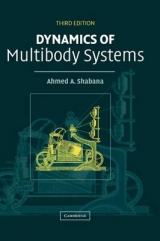
Dynamics of Multibody Systems
Seiten
2003
|
2nd Revised edition
Cambridge University Press (Verlag)
978-0-521-54411-5 (ISBN)
Cambridge University Press (Verlag)
978-0-521-54411-5 (ISBN)
- Titel erscheint in neuer Auflage
- Artikel merken
Zu diesem Artikel existiert eine Nachauflage
Large-scale mechanical systems such as automobiles consist of interconnected rigid and deformable components. These multibody systems present complex problems. This introduction to multibody dynamics emphasises flexible body dynamics. It discusses basic kinematics and dynamics, modeling, and newer computational techniques.
Automobiles, space structures, robots, and machines are examples of mechanical and structural systems that consist of interconnected rigid and deformable components. The dynamics of these large-scale, multibody systems are highly nonlinear, presenting complex problems that in most cases can only be solved with computer-based techniques. This book provides an introduction to the subject of multibody dynamics, with an emphasis on flexible body dynamics. The first chapter covers the basic ideas of kinematics and dynamics of rigid and deformable bodies. The book then moves on to advanced topics, including finite element formulations, and concludes with a clear, careful explanation of newer computational techniques. With its wealth of examples and practical applications, this book will be useful to graduate students, researchers, and practising engineers working with a wide variety of flexible multibody systems.
Automobiles, space structures, robots, and machines are examples of mechanical and structural systems that consist of interconnected rigid and deformable components. The dynamics of these large-scale, multibody systems are highly nonlinear, presenting complex problems that in most cases can only be solved with computer-based techniques. This book provides an introduction to the subject of multibody dynamics, with an emphasis on flexible body dynamics. The first chapter covers the basic ideas of kinematics and dynamics of rigid and deformable bodies. The book then moves on to advanced topics, including finite element formulations, and concludes with a clear, careful explanation of newer computational techniques. With its wealth of examples and practical applications, this book will be useful to graduate students, researchers, and practising engineers working with a wide variety of flexible multibody systems.
1. Introduction; 2. Reference kinematics; 3. Analytical techniques; 4. Mechanics of deformable bodies; 5. Floating frame of reference formulation; 6. Finite element formulation; 7. Large deformation problem; Appendix: Linear algebra; References; Index.
| Erscheint lt. Verlag | 16.10.2003 |
|---|---|
| Zusatzinfo | 89 Line drawings, unspecified |
| Verlagsort | Cambridge |
| Sprache | englisch |
| Maße | 189 x 247 mm |
| Gewicht | 700 g |
| Themenwelt | Mathematik / Informatik ► Informatik ► Theorie / Studium |
| Naturwissenschaften ► Physik / Astronomie ► Mechanik | |
| Technik ► Maschinenbau | |
| ISBN-10 | 0-521-54411-4 / 0521544114 |
| ISBN-13 | 978-0-521-54411-5 / 9780521544115 |
| Zustand | Neuware |
| Informationen gemäß Produktsicherheitsverordnung (GPSR) | |
| Haben Sie eine Frage zum Produkt? |
Mehr entdecken
aus dem Bereich
aus dem Bereich
Eine Einführung in die Systemtheorie
Buch | Softcover (2022)
UTB (Verlag)
CHF 34,95
was jeder über Informatik wissen sollte
Buch (2024)
Springer Vieweg (Verlag)
CHF 53,15



